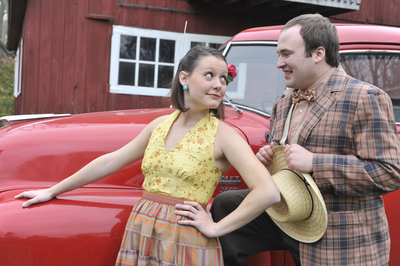U-M presenting classic Donizetti opera 'Elixir of Love'

Amy Petrongelli and Kyle Tomlin in "The Elixir of Love."
photo by Peter Smith Photography
You might say the University of Michigan University Opera Theatre exercises restraint in limiting revivals of Donizetti’s charming “Elixir of Love” (“L’Elisir d’Amore”) to once every 15 years or so.
After all, this Donizetti opera makes the Top 10 list of the most performed operas every year. But the company, composed of students at the U-M School of Music, Theatre & Dance, is mixing up another batch of love potion right now, and the brew will be ready for liberal quaffing Nov. 11-14 at the Power Center for the Peforming Arts.
The production, directed by Joshua Major and led by Martin Katz (and by Eiki Isomura on Sunday), conducting the University Symphony Orchestra, is sung in Italian with English supertitles.
PREVIEW
- Who: U-M's University Opera Theatre.
- What: Donizetti’s “Elixir of Love,” in Italian with English supertitles.
- Where: Power Center for the Performing Arts, 121 Fletcher Street.
- When: November 11-14: Thursday, 7:30 p.m.; Friday and Saturday, 8 p.m.; Sunday, 2 p.m. Post-performance discussions Friday and Saturday.
- How much: $18 and $24, $10 for students with ID; at the Michigan League Ticket Office, 734-764-2538 and online at www.music.umich.edu.
“Elixir’s” popularity comes from a heady mix of musical and dramatic elements. The story concerns a handsome young peasant, Nemorino, head-over-heels in love with Adina, who naturally fancies someone else, in this case, Belcore, a sergeant in the local garrison. To win her, he enlists the services of one of opera’s lovable charlatans, Dr. Dulcamara, whose “elixir” (aka, wine!) may just do the trick. Love conquers all in the end, but the getting there is more than half the fun.
“People love rooting for the underdog,” said conductor Katz, analyzing why “Elixir” is so popular. “And there aren’t too many tenors who are rejected until the last 10 pages of the score. Usually, the soprano melts under the gaze of the tenor; people prize tenors above all animals in the zoo. I think that has something to do with it.”
Another reason for “Elixir’s” popularity, said Katz, is that the music is “so darned accessible.”
“I wouldn’t go so far as to say the tunes are folksy, but they are easy to take on board,” he said.
He also noted that the opera is shorter than most: a 50-minute first act, a 40-minute second act. “That helps,” he said.
If Katz believes the story and length play a role in the opera’s popularity, as the “music guy” he is a fan of far more than Nemorino’s famous aria, “Una furtive lagrima,” an opera favorite made ultra-famous by the late Luciano Pavarotti.
“Everyone else sings his or her heart out, but the tenor sings this aria toward the end of the show, and it’s like nothing else ever happens,” said Katz. “The harp comes in to put a glow around the whole thing — it’s the only time it’s used in the show.”
People forget Dr. Dulcamara’s wonderful Act. I aria — “a dynamite piece,” Katz called it. Meanwhile, Adina, whose big Act II aria, a technical tour de force, follows “Una furtive lagrima,” is usually cheated of glory — especially since her aria is traditionally truncated.
Not in this production, in which the aria is sung without cuts, and with different ornamentation in the fast section the second time through. (Katz has constructed his own ornamented version of the score; even more exciting, with the opera double-cast, he has given each singer individual ornaments.)
Katz and Director Major agree that “Elixir” is one of those operas where it’s fine to tinker with the time period in which the opera is set. Major has returned to the 1950s — the period in which he set it for U-M in 1996 — for this production. Set design is by Jeff Bauer; Christianne Myers designs costumes and Gary Decker, the lighting.
“There’s something about the innocence of the period,” Major said, “that captures the spirit of ‘Elixir.’” And, he added, the landscape of rural Italy — the action takes place in a vineyard — has hardly changed in hundreds of years.
Another thing that has not changed, at least since U-M’s last “Elixir” production, is the 1950s red pickup truck that takes pride of place on stage. Back when he was doing the 1996 production, Major spied the truck on the street.
“I pulled up in front of the house, ran out, and said to the owner, ‘I’m doing a show — can we use your truck?’” They could, and they did.
Fast forward to 2010. Major sees a 1950s red pickup at Orion Automotive, on West Liberty Road. Rich Orion gets him the owner’s phone number. Major calls. The guy says, “Didn’t you use my truck before?”
He did, absolutely. And they will, absolutely, be using it again.
But no truck can steal the show from good singers, and Major says “the singing is fantastic.”
Katz says he has been thrilled with how the singers have taken to the bel canto style of Donizetti, which honors the voice above all else.
And Katz is happy to be giving Donizetti the hearing he deserves.
“Verdi gets all the credit for everything,” Katz said. “He happened to live when Italy became unified, and he was like a rock star. But the seed for everything he was able to do came from Rossini and Donizetti. Without them, Verdi would not have been able to carve out the incredible career he had.”
Susan Isaacs Nisbett is a free-lance writer who covers classical music and dance for AnnArbor.com.

